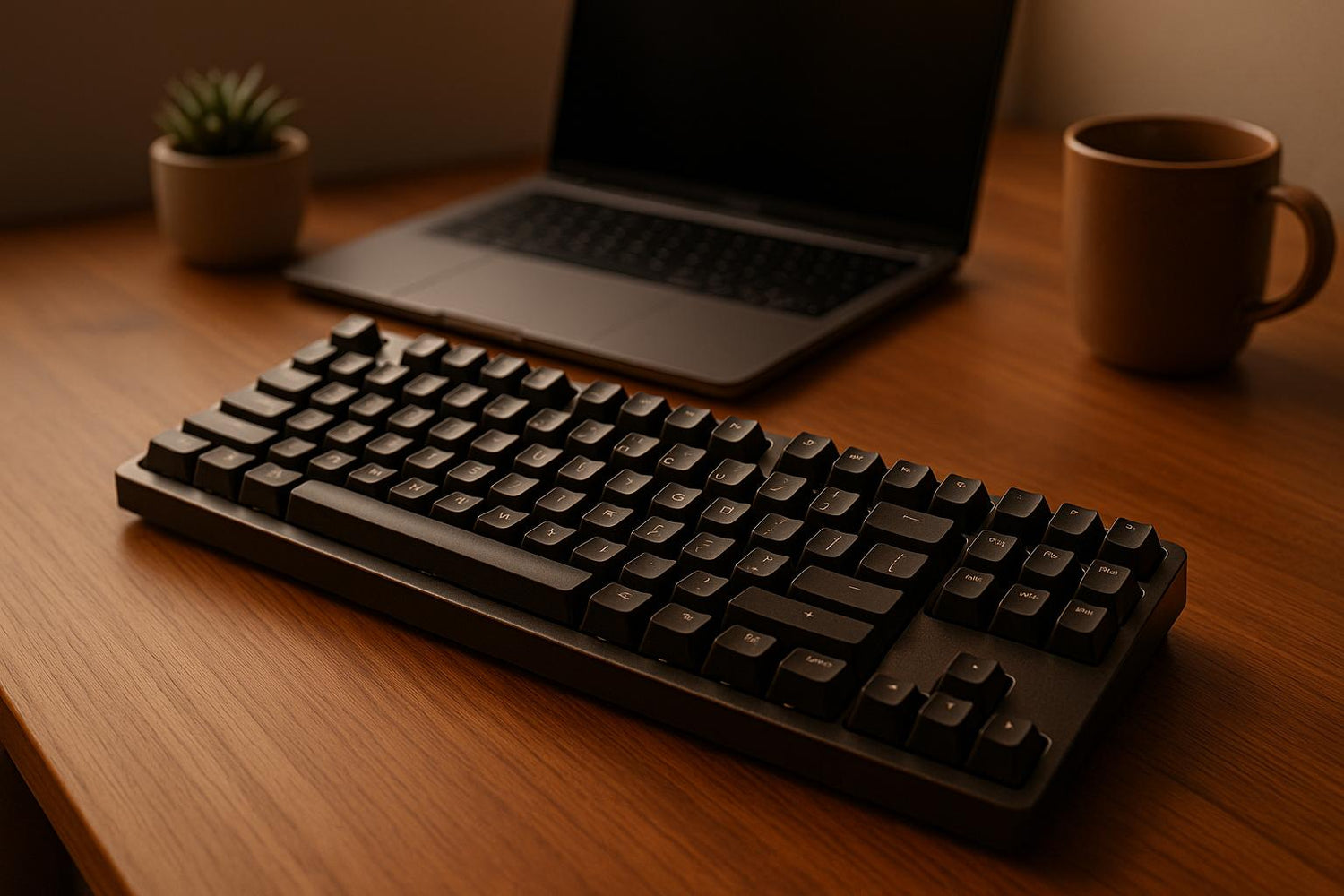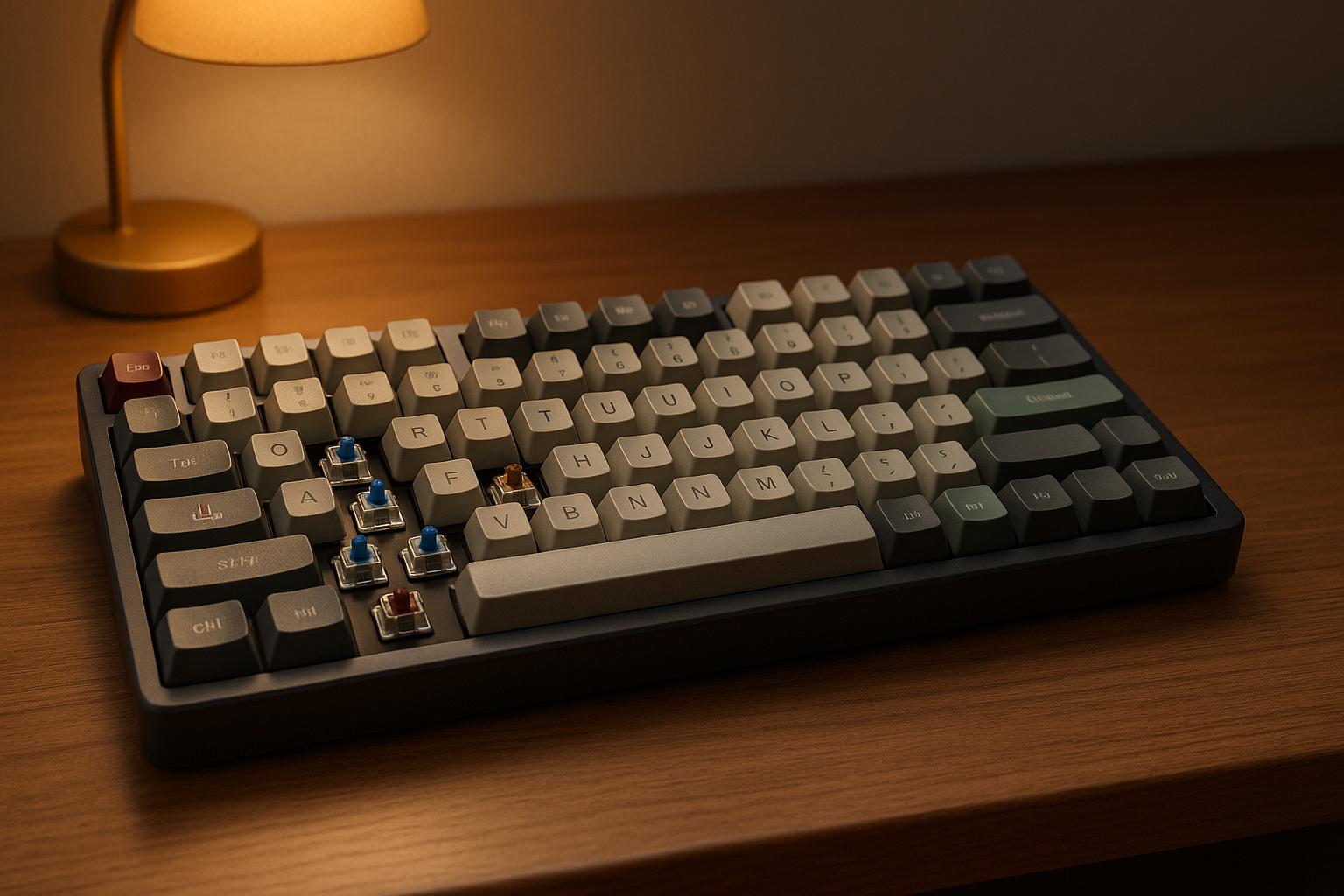Want a great deal on a keyboard without getting scammed? Buying a used mechanical keyboard can save you money, help the environment, and even land you rare finds like the IBM Model F. But it’s not risk-free. Here’s how to protect yourself and make smart purchases:
- Vet the Seller: Check reviews, ratings, and ask for proof of ownership (like receipts or dated photos). Avoid new or suspicious accounts.
- Inspect the Keyboard: Look for damage on cables, keycaps, or the PCB. Test every key and confirm the layout matches your needs.
- Avoid Scams: Watch out for fake listings, unrealistic prices, and off-platform payment requests. Use secure payment methods like credit cards or PayPal.
- Clean and Maintain: After purchase, clean and disinfect your keyboard, check for defects, and consider upgrades like better keycaps or sound-dampening foam.
Pro Tip: Platforms like KFA Marketplace specialize in second-hand mechanical keyboards and offer added buyer protection. Stick to trusted platforms to stay safe.
Follow these steps to enjoy a secure, hassle-free buying experience.
How to Research and Check Sellers
Before purchasing a used keyboard, it's crucial to verify the seller. A reliable seller can make all the difference between a smooth, satisfying transaction and a frustrating experience. Here are some practical steps you can take to ensure you're buying from someone trustworthy.
Review Seller History and Ratings
Start by examining the seller's history on the platform you're using, such as Facebook Marketplace or KFA Marketplace. Aim for sellers with ratings of 90% or higher. Take the time to read through both positive and negative reviews. Look for comments that mention shipping speed, product quality, and customer service. Repeated complaints about issues like slow shipping or inaccurate product descriptions should raise concerns.
Pay attention to how the seller handles negative feedback. A responsible seller will address complaints constructively, while ignoring or dismissing them might signal trouble. Be particularly cautious with new accounts that have little to no activity. In 2022, Americans lost over $1.2 billion to social media scams, highlighting the importance of vetting sellers thoroughly. Established sellers with a history of positive transactions are generally more trustworthy, as they have more to lose by engaging in dishonest behavior. Platforms like KFA Marketplace even allow you to review a seller's past transactions with other keyboard enthusiasts, which can provide added peace of mind.
Request Ownership Documentation
Legitimate sellers should be able to verify ownership of the item they’re selling. Ask for documentation, such as original receipts or timestamped photos of the keyboard. For higher-value items, consider requesting a photo of the keyboard next to a handwritten note that includes the current date and the seller's username. This ensures the seller actually has the item and isn’t using generic stock images.
If the seller hesitates or refuses to provide proof of ownership, it’s a good idea to walk away from the deal. Transparency is key when it comes to online transactions.
Test Seller Communication
A seller’s communication style can reveal a lot about their reliability. Reach out with specific questions about the keyboard’s condition, history, and features. Trustworthy sellers are usually knowledgeable about their items and can provide clear, detailed answers. Follow up with additional questions to test their responsiveness and willingness to assist.
If the seller provides a phone number, consider giving them a call. A quick conversation can help confirm their legitimacy and build trust. Be wary of sellers who pressure you to make a quick decision or suggest meeting in unusual or unsafe locations. Watch for warning signs like vague responses, reluctance to share additional photos, or a lack of detail in their answers.
As Kari Kammel, Director at the Center for Anti-Counterfeiting and Product Protection at MSU, advises: "One of the most important things you can do is know where you're shopping from."
Additionally, take a moment to verify the seller's contact information. A quick online search of any provided addresses can help confirm their authenticity. Sellers who are open about their location and business details tend to inspire greater confidence.
What to Check Before Buying
Once you've verified the seller, it's time to assess the keyboard's condition. A thorough inspection ensures you're getting something worth your investment.
Look for Physical Damage
Start by examining the keyboard for any visible damage. Pay close attention to the cable, as this is often a weak point, especially in older models. As Sai Sri Satyajit Bastia explains: "First thing you need to check before even the built quality is it's cable. Older keyboards had very bad cables compared to now. When a keyboard didnt work it was and still is because of the cable."
Check for fraying, kinks, or exposed wires along the cable. Move on to the keycaps - look for cracks, chips, or missing pieces, particularly on heavily used keys like WASD or the spacebar. Also, inspect the case for scratches, dents, or broken parts. Don’t forget to clean out any dirt or sticky residue lurking between the keys.
Test the Switches and PCB
After the physical check, make sure the keyboard functions properly. Open a word processor and test every key to confirm they register as expected. Don’t skip the special keys - volume controls, media buttons, or programmable keys should all work seamlessly.
If the keyboard allows for keycap removal, take a closer look at the switches. Check for bent pins, cracked housings, or uneven actuation force. You can also press multiple keys at once to confirm the keyboard supports proper key rollover.
For the PCB (printed circuit board), inspect for signs of liquid damage, such as corrosion or discoloration. Look out for broken traces or burn marks, which could indicate electrical issues.
Verify Layout and Features
Finally, make sure the keyboard layout aligns with your preferences. Whether you’re after a compact 60%, a versatile 75%, or a full TKL (tenkeyless) design, double-check the layout in the photos provided by the seller.
Ask about hot-swappable switches - this feature allows you to replace switches without soldering, making customization much easier. Also, confirm the keyboard uses USB-C for compatibility with modern devices.
If you're considering a gaming or international configuration, verify multi-layout support directly with the seller. Keep in mind that each layout has its own perks: 60% keyboards save desk space by skipping function keys, while TKL models balance compactness and functionality by removing only the number pad.
Mechanical keyboards are known for their durability compared to membrane ones, but a thorough inspection ensures your purchase will last for years to come.
How to Spot and Avoid Scams
Once you've confirmed the seller's details and the product's condition, the next step is protecting yourself from scams. The used keyboard market, unfortunately, attracts scammers looking to take advantage of unsuspecting buyers. Recognizing the warning signs and taking preventive steps can save you both money and a lot of hassle.
Identify Common Fraud Tactics
Scammers often rely on predictable tricks that, with some awareness, you can easily spot. One of the most common is fake listings - these are ads featuring keyboards the scammer doesn't actually have. They often use stolen photos from legitimate sellers or manufacturer websites, and the images tend to look overly polished or professional.
Another big warning sign is unrealistic pricing. If you come across a $400 custom mechanical keyboard listed for $100, it's likely too good to be true. Deals that seem "too perfect" are often scams.
Beware of broken electronics scams, where sellers knowingly ship non-functional keyboards and then disappear once they've been paid. Another scheme to watch for is the overpayment scam. Here, a scammer sends you more money than you asked for and then requests a refund for the difference. The catch? They're using stolen payment methods, leaving you responsible when the original transaction is reversed.
Scammers are also getting better at crafting fake payment confirmation emails. These emails often look convincing but usually come from free email services like Gmail or Yahoo instead of official payment platforms. Always verify payments directly through the payment platform, not just by relying on email notifications.
Finally, avoid sellers who push for off-platform communication. This is a common tactic to gather your personal information and dodge the protections offered by official platforms.
Use Protected Payment Options
The payment method you choose can be the difference between recovering from a mistake and losing your money entirely. Credit cards are your best bet, as they come with strong fraud protection policies, including the ability to dispute unauthorized charges. Many issuers also offer zero-liability policies for fraudulent transactions.
PayPal is another solid option, offering features like end-to-end encryption, fraud detection, and round-the-clock transaction monitoring. To benefit from their Purchase Protection, ensure your transactions are marked as "Goods & Services" rather than personal payments.
Digital wallets are also a safer choice, thanks to their encryption technology. Similarly, virtual credit cards provide an extra layer of security by generating unique card numbers for each transaction, keeping your actual credit card details safe.
On the other hand, steer clear of direct wire transfers - these are nearly impossible to reverse once completed. Debit cards pose more risk than credit cards, as they directly access your bank account and often have weaker fraud protections. Likewise, prepaid debit cards usually lack policies to recover lost funds.
Never use gift cards or money orders for payments. These methods are classic tools for scammers and offer no protection if something goes wrong.
Shop on Reliable Platforms
Choosing a trustworthy platform is just as important as vetting the seller. Platforms like KFA Marketplace (https://kfamarketplace.com) specialize in second-hand mechanical keyboards, creating a safer space for the keyboard community. This platform connects verified sellers with buyers who are looking for quality used keyboards.
Reputable platforms also offer buyer protection policies and dispute resolution processes that individual sellers can't provide. Many of these marketplaces have seller verification systems and transaction monitoring, which help flag suspicious activity before it affects buyers.
When assessing a platform, check the seller's profile for completeness. Legitimate sellers typically include photos and detailed descriptions in their profiles. Read through user feedback and reviews to spot any red flags from past transactions. If you're unsure, ask the seller for recent photos of the keyboard with your name or the current date written on a sticky note. This helps confirm they actually have the item.
Throughout the process, trust your instincts. If something feels off - whether it's strange communication, unanswered questions, or unusual payment requests - take a step back and reconsider the deal. Genuine sellers understand buyer caution and are usually happy to provide extra verification when asked.
Keep a clear record of all transactions and stay informed about new scam tactics. While the mechanical keyboard community is generally reliable, taking these steps will help ensure a safe and positive buying experience.
sbb-itb-3cb9615
What to Do After Purchase
Getting your keyboard delivered is just the beginning. The steps you take after your purchase are crucial for ensuring it’s authentic and performing at its best. A few checks and upgrades can help confirm your investment was worthwhile.
Clean and Disinfect Your Keyboard
Start by giving your keyboard a proper cleaning. Used keyboards can collect dust, bacteria, and even viruses, so cleaning isn’t just about looks - it’s about hygiene and functionality. Melissa Maker, Owner of Clean My Space, advises:
"When cleaning a keyboard, you have a couple of things to think about. What falls inside is the first thing to worry about, and the second is the surface of the keys."
Begin by unplugging the keyboard. Flip it upside down and gently shake it to dislodge loose debris. Then, use compressed air in short, upright bursts, moving in a zigzag pattern to clear out crumbs and dust. For the surface, wipe it down with a microfiber cloth slightly dampened with water.
For tougher spots, use a microfiber cloth with 70% or higher isopropyl alcohol. To disinfect properly, let the surface remain wet for about three minutes, but avoid soaking the keyboard.
If you’re up for a deeper clean, remove the keycaps using a keycap puller. Soak them in warm, soapy water for about 30 minutes. While they soak, clean the exposed keyboard surface with cotton swabs dipped in isopropyl alcohol. Once the keycaps are rinsed and completely dry, reassemble the keyboard. For those hard-to-reach areas, keyboard cleaning gel can work wonders by picking up dust and grime between switches.
Once your keyboard is spotless, you’re ready to focus on improving its performance.
Service and Upgrade Components
Regular maintenance is key to keeping your keyboard in top shape. It can prevent issues like sticky keys or unresponsive switches, especially on older models.
Start by lubricating the switches. This reduces friction and ensures smoother key presses. For larger keys like the spacebar or Enter, consider applying a thin layer of lubricant to the stabilizers to improve their movement and prevent sticking.
If the keycaps are worn or feel cheap, replacing them can make a big difference. PBT double-shot keycaps are a great upgrade - they’re more durable and provide a better tactile feel than thinner ABS keycaps.
For a quieter typing experience, consider adding sound-dampening foam inside the keyboard case. This reduces unwanted noise and gives your keyboard a more refined feel. Don’t overlook the cable, either - upgrading to a braided or coiled cable can add both durability and style.
Verify Product Details
Once your keyboard is cleaned and serviced, take a moment to ensure it matches the seller’s description. This step confirms you received what you paid for and helps identify any potential issues.
Test every key to make sure it’s responsive and consistent. Pay extra attention to special function keys, as they’re often essential for daily use. If possible, remove a few keycaps to inspect the switches underneath. Look for any signs of wear, such as rough action, slow rebound, or debris buildup.
Check the cable for fraying or other damage if it’s a wired keyboard. For wireless models, inspect the battery compartment for corrosion or physical damage. Type a few lines to listen for any unusual sounds or irregularities.
Finally, ensure any required software or drivers are installed and working properly. If you notice any discrepancies - such as missing features or unexpected damage - document them with photos. This will be helpful if you need to contact the seller or request support through the platform.
Key Points for Safe Keyboard Purchases
When buying a used mechanical keyboard, safety and satisfaction hinge on a few critical practices: verifying the seller, thoroughly inspecting the product, using secure payment methods, and caring for your purchase afterward. Here's how to navigate each step confidently:
Verify the seller. Always check the seller's history and ratings on the platform you're using. Ask for ownership documentation to ensure transparency. A trustworthy seller will respond promptly and provide clear answers to your questions.
Inspect the keyboard carefully. Look for cracks, missing keys, or any visible damage. Connect the keyboard to test every key, including special function keys like volume or media controls. For wired models, inspect the cable for wear or fraying. For wireless models, check the battery compartment for corrosion or damage.
Choose secure payment methods. Stick to credit cards or secure platforms like PayPal, which offer Buyer Protection. This feature can reimburse your purchase amount and shipping costs if the item doesn’t arrive or isn’t as described. Thorin Klosowski, Wirecutter's lead editor of privacy and security, emphasizes the importance of secure payments:
"It'll be easier to monitor fraud that way", he explains, noting that you can freeze your account and file a fraud complaint with your credit card company if issues arise.
This advice is particularly relevant given that over 173,000 cases of online shopping fraud were reported to the Federal Trade Commission in 2019.
Maintain your keyboard after purchase. Start by cleaning and disinfecting it to address hygiene concerns. Check all keys and features to confirm they match the seller’s description. Over time, service key components like switches and stabilizers as needed to keep your keyboard in top shape.
Consider platforms with buyer protection policies for added security. For example, the KFA Marketplace (kfamarketplace.com) is a dedicated space for buying and selling used custom mechanical keyboards. It includes built-in seller verification and secure transaction processing, making it a reliable option for enthusiasts.
FAQs
How can I make sure a used keyboard is authentic before buying it?
To determine if a used keyboard is genuine, start by giving it a close look. Examine its condition for any unusual wear, like excessive scratches or missing components, that might not match its expected age. If you can, test the keyboard to ensure all keys, switches, and special features are functioning as they should.
Look for a serial number on the keyboard and cross-check it with the manufacturer to ensure it hasn't been altered. If the seller includes original packaging or documentation, these can be helpful in confirming authenticity. Additionally, take some time to research the seller's reputation. Check reviews or feedback to ensure they're reliable. Platforms like the KeebsForAll Marketplace provide a trusted space for buying and selling second-hand mechanical keyboards, making the process more secure within the community.
What are the warning signs of a scam when buying used keyboards online?
When browsing for used keyboards online, keep an eye out for these common warning signs:
- Prices that seem too low: If a deal feels too good to be true, it likely is.
- Lack of transparency: Sellers who avoid providing clear photos, detailed specs, or answering questions about the keyboard should raise concerns.
- Risky payment methods: Be wary of sellers asking for wire transfers or other insecure payment options.
- Spotty communication: Sellers who respond poorly or dodge questions might not be reliable.
- Suspicious photos: Low-quality images or pictures that don’t match the product description could signal a scam.
For a more secure buying experience, try using trusted platforms like KeebsForAll’s second-hand marketplace, where buyers and sellers can connect with greater confidence.
How do I clean and maintain a used keyboard after buying it?
To keep your used keyboard clean and in good shape, start by unplugging it for safety. Use a keycap puller to carefully remove the keycaps, then turn the keyboard upside down and give it a gentle shake to dislodge any loose debris. Next, grab a can of compressed air to blow away dust and particles from the switch plate. For the keycaps, you can either soak them in warm, soapy water or wipe them down with a damp cloth. Just ensure they’re completely dry before snapping them back into place.
For ongoing care, wipe the keyboard surface with a microfiber cloth and use a soft brush to clean between the keys once a week. This simple upkeep routine can help prevent dirt buildup and keep your keyboard working smoothly for a long time.



![[Pre-Order] Autumn Leaves PBT Keycaps - KeebsForAll](http://keebsforall.com/cdn/shop/products/DSC09732.jpg?v=1676148273)






Leave a comment
This site is protected by hCaptcha and the hCaptcha Privacy Policy and Terms of Service apply.